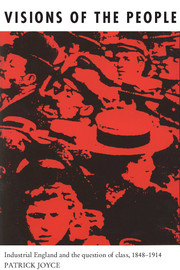Book contents
- Frontmatter
- Contents
- List of plates
- Acknowledgements
- 1 Introduction: beyond class?
- PART I POWER AND THE PEOPLE: POLITICS AND THE SOCIAL ORDER
- PART II MORALISING THE MARKET: WORK AND THE SOCIAL ORDER
- PART III CUSTOM, HISTORY, LANGUAGE: POPULAR CULTURE AND THE SOCIAL ORDER
- PART IV KINGDOMS OF THE MIND: THE IMAGINARY CONSTITUTION OF THE SOCIAL ORDER
- 9 Investigating popular art
- 10 The broadside ballad
- 11 The voice of the people? The character and development of dialect literature
- 12 Dialect and the making of social identity
- 13 Stages of class: popular theatre and the geography of belonging
- 14 Summary and conclusion: the making of the English working class before 1914?
- Appendices
- Bibliographical note
- Notes
- Index
11 - The voice of the people? The character and development of dialect literature
Published online by Cambridge University Press: 05 March 2012
- Frontmatter
- Contents
- List of plates
- Acknowledgements
- 1 Introduction: beyond class?
- PART I POWER AND THE PEOPLE: POLITICS AND THE SOCIAL ORDER
- PART II MORALISING THE MARKET: WORK AND THE SOCIAL ORDER
- PART III CUSTOM, HISTORY, LANGUAGE: POPULAR CULTURE AND THE SOCIAL ORDER
- PART IV KINGDOMS OF THE MIND: THE IMAGINARY CONSTITUTION OF THE SOCIAL ORDER
- 9 Investigating popular art
- 10 The broadside ballad
- 11 The voice of the people? The character and development of dialect literature
- 12 Dialect and the making of social identity
- 13 Stages of class: popular theatre and the geography of belonging
- 14 Summary and conclusion: the making of the English working class before 1914?
- Appendices
- Bibliographical note
- Notes
- Index
Summary
From around the 1840s there developed in Lancashire, Yorkshire and the north-east of England a dialect literature of wide appeal to the working people of these industrial districts. A popular tradition was apparent in some other English regions, but these examples were overwhelmingly the most significant. In other regions, too, dialect was written by and for those outside the ranks of manual workers: this aspect will be considered later, the main emphasis here being upon the popular current. If decidedly popular, however, this dominant form was in no sense the direct expression of some authentic ‘working-class’ voice. Rather, its genesis and character were culturally and socially diverse: while there were two distinct strands in the literature these were in practice sometimes woven together. Unpicking this weave helps us explore people's self-images and the ideas they had of other social groups.
It is first of all necessary to convey briefly some of the main characteristics of what I take to be the dominant, popular current in dialect. It was a new literature, yet was also intimately related to the ballad tradition and oral culture that preceded it. What was new was the emergence of known, no-longer anonymous authors, writing in an often ‘literary’ way for a mass audience. With more justice than with the ballad, one may use the term ‘literature’ in the sense of awareness and pretentions extending from ‘low’ to ‘high’ literary culture.
- Type
- Chapter
- Information
- Visions of the PeopleIndustrial England and the Question of Class, c.1848–1914, pp. 256 - 278Publisher: Cambridge University PressPrint publication year: 1991
- 1
- Cited by



